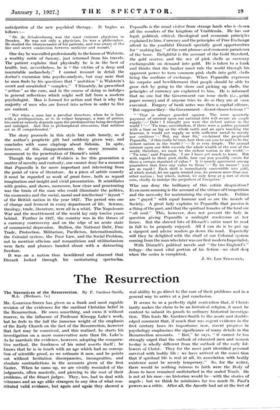The Resurrection
The Narratives of the Resurrection. By P. Gardner-Smith, M.A. (Methuen. Cs.) Mn. GARDNER-SW][31 has given us a frank and most capable revision of the evidences for the cardinal Christian belief in the Resurrection. He owes something, and owns if without reserve, to the influence of Professor Kirsopp Lake's work, but he- feels to the full the immense weight of the emphasis of the Early Church on the fact of the Resurrection, however that fact may be conceived, and this realized, he starts his investigation on a more conservative note than Dr. Lake's. As he marshals the evidence, however, adopting the compara- tive method, the frankness of his mind asserts itself ; he knows that he is in touch with an age which had no concep- tion of scientific proof, as we estimate it now, and he points out without hesitation discrepancies, incongruities, and absolute contradictions in the accounts given of the first Easter. When he sums up, we are vividly reminded of the judgments, often masterly, and piercing to the root of their problems, of the Stuart judges. They, too, had to deal with witnesses and an age alike strangers to any idea of what con- stituted valid evidence, but again and again they showed a
real ability to go direct to the core of their problems and in a general way to arrive at a just conclusion.
It seems to us a perfectly right contention that, if Christ- ianity makes the claim to he an historical religion, it must be content to submit its proofs to ordinary historical investiga- tion. This leads Mr. Gardner-Smith to the acute and double- edged comment that, if much that was cogent evidence in the first century loses its importance now, recent progress in psychology emphasizes the significance of many details in the Resurrection accounts. " But," he says, " it cannot be too strongly urged that the outlook of educated men and women to-day is wholly different from the outlook of the early fol- lowers of Christ. They for the most part identified personal survival with bodily life ; we have arrived at the conviotion that if spiritual life is real at all, its association with bodily existence must be merely temporary." So, for the writer, there would be nothing ruinous to faith were the Body of Jesus to have remained undisturbed in the sealed Tomb. He is not at his case—no historian would be—with the stories of angels : but we think he minimizes far too much St. Paul's powers as a critic. After all, the Apostle had sat at the feet of Ganialiel, and was versed in Rabbinic lore ; he showed acquaintance with Greek literature, certainly with Aratus of Soli, possibly with Pindar and Aristophanes ; he was a Roman citizen, holding his own in Roman law-courts ; he was what we should call " a University man " and emphati- cally a man of affairs. His omissions, such as the appearances to the women, the mention of the Empty Tomb, and the appearance to Thomas are perplexing, but also extremely interesting. So is his inclusion of his own vision with the appearances. As to the Tomb, there is another omission which hardly any, if any, commentators note. St. Peter, in Acts ii, draws attention to the Sepulchre of David, but, just as we think he is about, naturally, to compare it with that of Jesus, the argument breaks off ; nor, strange to say, do his opponents point to the hiatus. Could Pilate, anticipating a riot, have ordered the destruction of the Tomb ? Against this are to be set the Roman reluctance to violate sepulchres—their sen- tences ended with death—and also the persistence of the legend of the Site. Yet the absence of appeal from either side to a proof lying close at hand is baffling. In this connexion it may be noted that Mr. Gardner-Smith discredits the story of the guard, and believes that " John," who he thinks was not the son of Zebedee, had in mind a grave dug in the ground, and not a sepulchre hewn upright in the rock. He adds an interesting Appendix on Jewish rock-tombs.
We have made some notes on a book whose carefulness and reverence are everywhere in evidence, and must command the study of those who will be inclined to dispute some of its verdicts. To our thinking the accounts of the Resurrection invite analysis, in the light of present-day thought—analysis which might well prove constructive and confirmatory, and we welcome Mr. Gardner-Smith's contribution, with its atmosphere of free criticism, and an ultimate faith, as a very valuable instalment.



































 Previous page
Previous page